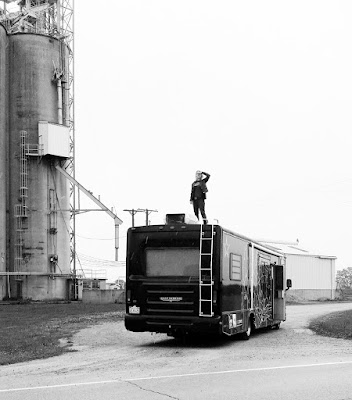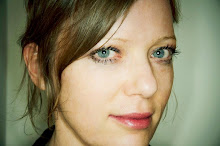The Calligraphy Challenge is a performative gestural text intervention by Norwegian Artist Anne Katrine Senstad. It was performed as part of the CULTURUNNER initiative and funded by Edge of Arabia and Office for Contemporary Art Norway July 5 - 12 2015. Organized by Edge of Arabia founder Stephen Stapleton and curator Ava Ansari.
CULTURUNNERS is a road trip initiative across the U.S. in a media outfitted RV bus organized by Edge of Arabia in partnership with Art Jameel for art and cultural practitioners from diverse backgrounds.
As a starting point I received a series of Farsi calligraphy instructions from Marco Say, a calligraphy expert based in Teheran as an initiation to my Calligraphy Challenge Project. (Farsi and Arabic alphabet are the same but Farsi has 4 more words). The idea behind my project The Calligraphy Challenge was to practice Arabic and Farsi calligraphy as a beginner and non-arabic speaker in a shaky, unstable RV bus on highways and country roads as a geo-performative text intervention with physical obstruction, challenging the quiet meditative process and action of studying calligraphy introducing physical resistance in the learning process, and a displacement of language to an unexpected environment and culture. It also refers to the idea of the nomadic traditions and travelling artist intervening culturally with people and new locations one would enter by administering the "poison" of the foreign into their environment. Languages and culture have historically been transformed and merged through exchange, trade, travel, storytelling, diaspora and colonialization. American culture shows both a hybridization and a stagnation of national identities, religions and languages from the numerous waves of colonial immigration, and later economical immigration, by integration of cultures as well as a need for preservation of original culture and language. Pioneers and religious outcasts chiefly from Europe established new townships and communities using biblical names reflecting their ideas of Utopia, such as Palestine, Jericho, Zion, Babylon, Jericho, Jerusalem,Salem, New Canaan and so on. The majority Amercian town names settled by pioneers reflect the geographical origin of the settlers such as Fredericksburg Manchester, New Amsterdam etc, or the names referring to the main settler family such as Jonestown or Margaretsville. Other names originate from Native American names or tribes such as Mineola, Chappaqua or Massapequa, or the numerous Spanish catholic names found in California, New Mexico and Texas.
As a participating artist from Norway
and based in New York I wanted to be challenged by and introduced to the Arabic and Farsi
Alphabet informed by my previous art projects and experiences in the middle
east and a variation of earlier works aestheticizing language, production of
social political implied statements and lyrical sentences for the public space
as art intervention. These linguistic processes are informed by the idea of
advertisement psychology and the economy of public language, anthropologically inspired considerations, mass communication as power, as well as
the emotional and intellectually implied realms of poetry and literature. As a gestural performative handwriting study of an unfamiliar language, the process of
learning Arabic calligraphy is abstract and lent itself to exploring the physicality
of automated writing and study of the line, removing the control of the
intellect and analytical aspects of reading and writing ones mother tongue.
Adding on a moving RV bus on highways and country roads as classroom with sound
and spatial interference, with a constant change of location, the learning
process is then additionally challenged and liberated from traditional
constraints.
The employment of language as aesthetic
and as transportation for ideas and phenomenological domains, influences
our perceptions by way of communication, philosophy, psycho-geographical
spaces, through engagement and absorption of the process - the
performative in action in relation to, and in response to language.
The Calligraphy Challenge, learning to write Arabic on a shaky unstable RV bus going from New York to Detroit.
The Calligraphy Challenge, learning to write Arabic on a shaky unstable RV bus going from New York to Detroit.
As a starting point I received a series of Farsi calligraphy instructions from Marco Say, a calligraphy expert based in Teheran as an initiation to my Calligraphy Challenge Project. (Farsi and Arabic alphabet are the same but Farsi has 4 more words). The idea behind my project The Calligraphy Challenge was to practice Arabic and Farsi calligraphy as a beginner and non-arabic speaker in a shaky, unstable RV bus on highways and country roads as a geo-performative text intervention with physical obstruction, challenging the quiet meditative process and action of studying calligraphy introducing physical resistance in the learning process, and a displacement of language to an unexpected environment and culture. It also refers to the idea of the nomadic traditions and travelling artist intervening culturally with people and new locations one would enter by administering the "poison" of the foreign into their environment. Languages and culture have historically been transformed and merged through exchange, trade, travel, storytelling, diaspora and colonialization. American culture shows both a hybridization and a stagnation of national identities, religions and languages from the numerous waves of colonial immigration, and later economical immigration, by integration of cultures as well as a need for preservation of original culture and language. Pioneers and religious outcasts chiefly from Europe established new townships and communities using biblical names reflecting their ideas of Utopia, such as Palestine, Jericho, Zion, Babylon, Jericho, Jerusalem,Salem, New Canaan and so on. The majority Amercian town names settled by pioneers reflect the geographical origin of the settlers such as Fredericksburg Manchester, New Amsterdam etc, or the names referring to the main settler family such as Jonestown or Margaretsville. Other names originate from Native American names or tribes such as Mineola, Chappaqua or Massapequa, or the numerous Spanish catholic names found in California, New Mexico and Texas.
The focus of my project The
Calligraphy Challenge and choice of words was influenced by destinations determined by my fellow CULTURUNNER artists projects, and served as a joint cross cultural effort. On our way to
East Palestine, Ohio, New Palestine, Indiana, Palestine Lake, Indiana and
Detroit, Michigan, I practiced writing these town names on calligraphy friendly paper. For the text
intervention I wrote the Arabic versions of the town names on pink, white and
mirrored Plexi glass signs that I would then document on location by asking
locals to hold while photographing them in their natural surroundings.
I also included a political text in Farsi Calligraphy, relating to my ongoing social political concerned works and not place-specific to the RV journey, yet still in the context of the intervention as it would include practicing Farsi Calligraphy. The text "Saudi America" refers to my ongoing research project "Capitalism in the public realm", and is included in the Bruges Art and Architecture Triennial 2015.
I also included a political text in Farsi Calligraphy, relating to my ongoing social political concerned works and not place-specific to the RV journey, yet still in the context of the intervention as it would include practicing Farsi Calligraphy. The text "Saudi America" refers to my ongoing research project "Capitalism in the public realm", and is included in the Bruges Art and Architecture Triennial 2015.
Learning Farsi Nastaliq Calligraphy on a moving RV bus.
Text: Saudi America. The inclusion of my political criticism text "Saudi America" is based on joining the ongoing text practice I have developed, utilizing the situation to include the Arabic written language.
Learning Farsi Nastaliq Calligraphy on a moving RV bus. Text: Detroit
Farsi Nastaliq Calligraphy provided by master calligrapher Marco Say in Teheran.
Text: Palestine, Ohio

Learning Arabic Calligraphy on a moving RV bus.
Text: Palestine Lake, Indiana
Location: Palestine, Indiana that also features a Palestine Lake. Arabic text written in a shaky unstable environment on pink plexiglass, 12x12 inches.Text: Palestine Lake, Indiana. The locals holding the signs are retirees who have chosen to live in affordable low population states such as in Indiana.
Along the journey I expanded the texts
to include practicing Arabic sentences based on words as a travelling
communication, the traveller's absence and the experience of the exiled/diasporic longing and
nostalgia. The sentences, romantic in nature were “You are my angel”, “You take my heart”, “You are my Life”, “Eternal
kisses”, “Hugs forever”. The sentences were given to me along the way while on
the road, 1 new sentence per day. The english translation of the sentences is a
direct word by word translation into English from Arabic, not necessarily exact
expressions one would use in English (like “Hugs forever”). The Arabic
sentences are authentic, so as a Norwegian non Arabic speaking artist, the
performative action creates a bridge between cultures and language, stating
commonalities between nationalities, the universal, the personal, the
intimate and sense of time and place.

1st Text: Eternal Kisses
2nd Text: You Are my Life
3rd Text: You Take my Heart x 2
4th Text: Hugs Forever
5th Text: You Are My Angel
Practicing Arabic sentences allowed me a
glimpse into the culture-specific nuances of Arabic writing and speech, the differences between
the middle eastern languages. We published the progress of my Arabic learning
through documentation imagery and film on CULTURUNNERS website and social media so the
calligraphy advisors, artists and friends could follow the development, journey
and supply feedback. At the starting point, day 1 on the bus, I was told my
Arabic handwriting resembled a 5 year olds hand writing, by day 2 and 3 the
social media feedback from total strangers in the Middle east who had picked up on the published Calligraphy Challenge material and process-journey, as well as Arabic
speaking people in Norway and US, became more engaged, encouraging and generously offering suggestions to changes,
corrections of mistakes and explanations of the differences in Arabic
alphabet, as well as explanations in the variations of Farsi Calligraphy. By day 4 and 5, the
Arabic speaking followers had grown in number and responses, open mindedly
cheering me on and supporting my progress, graduating my Calligraphy to the "not bad" and "pretty good" level.
As part of the first lap of the
RV road trip across America, Culturunners organizer and founder Stephen
Stapleton and curator Ava Ansari hosted lectures and events at the
Red Bull Art Space in Detroit the weekend of July 18-19 with artists Sarah
Ouhaddou, Salar Ansari, Peyman Shafieezadeh, Lila Nazemian and John
Mireles. The RV road trip is currently continuing its journey through America
with a variation of international artists and projects related to place and
cultural exchange.














